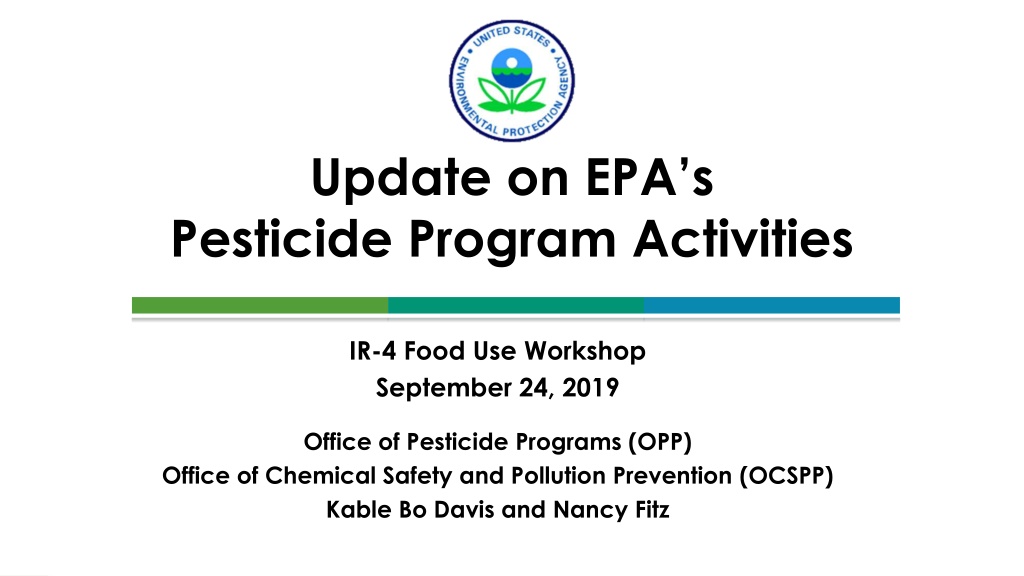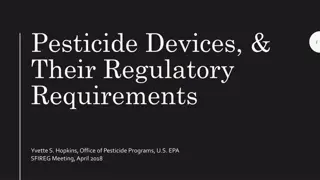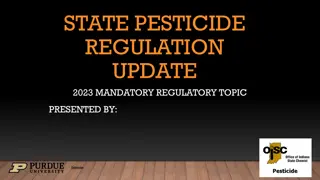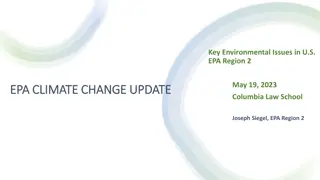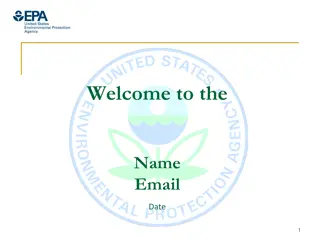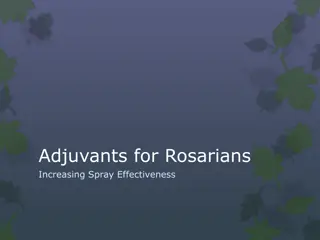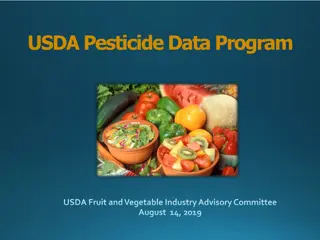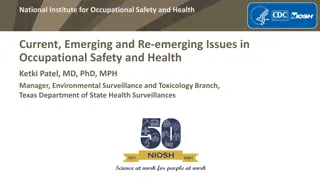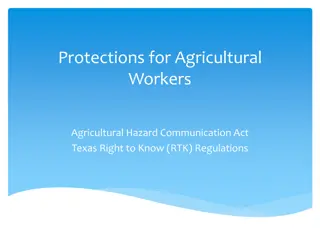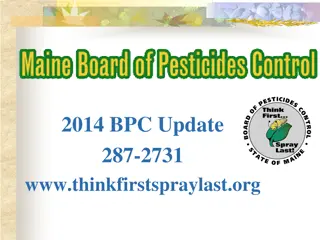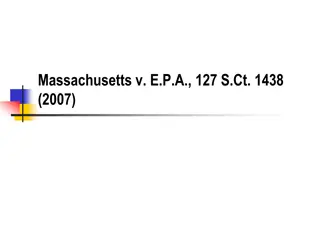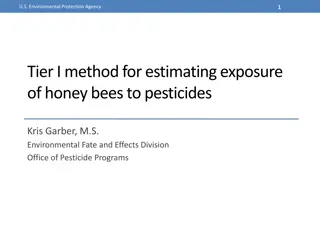EPA Pesticide Program Activities Update
The update on EPA's Pesticide Program Activities, including discussions on big news in 2019, registration review, specific chemicals updates, and more. Details on the Assistant Administrator for OCSPP and PRIA update are also featured. Learn about Registration Review and its progress in FY19 Q3.
Download Presentation

Please find below an Image/Link to download the presentation.
The content on the website is provided AS IS for your information and personal use only. It may not be sold, licensed, or shared on other websites without obtaining consent from the author.If you encounter any issues during the download, it is possible that the publisher has removed the file from their server.
You are allowed to download the files provided on this website for personal or commercial use, subject to the condition that they are used lawfully. All files are the property of their respective owners.
The content on the website is provided AS IS for your information and personal use only. It may not be sold, licensed, or shared on other websites without obtaining consent from the author.
E N D
Presentation Transcript
Update on EPAs Pesticide Program Activities IR-4 Food Use Workshop September 24, 2019 Office of Pesticide Programs (OPP) Office of Chemical Safety and Pollution Prevention (OCSPP) Kable Bo Davis and Nancy Fitz
Discussion Topics Big News in 2019 Registration Review Update Updates on Specific Chemicals Antibiotics Registration Division Accomplishments Import Tolerance Pilot Project Crop Group Proposed Rule Hemp 2
Assistant Administrator (AA) for OCSPP Alexandra (Alex) Dapolito Dunn. Confirmed January 2, 2019. Previously served as the Regional Administrator for EPA Region 1 in Boston, Massachusetts for one year. 3
PRIA Update On March 8, 2019, the Pesticide Registration Improvement Extension Act of 2018 (PRIA 4) was signed into law: Reauthorizes PRIA for five years (through FY 2023) Category changes Increases number of registration service fee categories from 189 to 212 M009: non-FIFRA regulated determinations (e.g., minimum risk, treated articles) Enhances incentives for reduced-risk pesticide submissions by raising fees for the corresponding non-reduced risk categories (new conventional active ingredients and new uses) by 20% 4
5 What is Registration Review? Statutory Mandate FIFRA Section 3(g) requires EPA to review each registered pesticide every 15 years Scope ~725 cases encompassing over 1,100 pesticide active ingredients (A.I.) Conventional, antimicrobial, and biopesticides Statutory Deadline EPA must complete review of all pesticides by 10/1/2022 Registration review Program: https://www.epa.gov/pesticide-reevaluation/registration-review-process Registration Review Schedule: https://www.epa.gov/pesticide-reevaluation/registration-review- schedules 5
Registration Review Progress (FY19 Q3) Conventionals: 353 draft risk assessments completed (~23% remaining) 270 proposed interim decisions complete (~41% remaining) 235 final or interim decisions complete (~49% remaining) Antimicrobials: 67 draft risk assessments completed (~51% remaining) 57 proposed interim decisions complete (~58% remaining) 53 final or interim decisions complete (~61% remaining) Biopesticides: 90 draft risk assessments completed (~29% remaining) 90 proposed interim decisions complete (~29% remaining) 71 final or interim decisions complete (~42% remaining) 6
Glyphosate On May 6, 2019, EPA opened a 60-day public comment period on a Glyphosate Proposed Interim Decision. The comment period has been extended to September 3, 2019. The proposed interim decision proposes the following mitigation and label changes to target pesticide sprays on intended pests, protect pollinators, and reduce the problem of weeds becoming resistant to glyphosate: Spray drift management measures (e.g., release height, droplet size, and wind speed restrictions) to reduce off-site exposure to non-target wildlife. Weed resistance management labeling (e.g., information on mode of action, scouting instructions, and reporting instructions for weed resistance). Label consistency measures, including updating maximum application parameters, updating the environmental hazards statement for aquatic use, and clarification on rotational crop timing. Updated label language to raise awareness of potential effects to pollinator habitat and instructions on minimizing spray drift. 7
Glyphosate EPA continues to find that there are no risks to public health when glyphosate is used in accordance with its current label and that glyphosate is not a carcinogen. EPA s scientific findings on human health risk are consistent with the conclusions of science reviews by many other countries and other federal agencies. After reviewing public comments on the PID, EPA intends to release an interim decision in late 2019. 8
Pyrethroids 2016/2017: EPA published draft risk assessments for public comment 2018: Consider public comments submitted, revise risk assessments based on new data and comments 2019: Plan to publish proposed interim decisions 2020: Plan to publish interim decisions 9
Neonicotinoid Update 2010-2011: Imidacloprid, thiamethoxam, clothianidin, and dinotefuran 2014: Published a benefits assessment on the treatment of soybean seeds with neonicotinoids 2016-2017: Published the preliminary pollinator assessments 2017: Published draft human health risk assessment 2017: Published additional benefits assessments on cotton and citrus, along with a revised seed treatment assessment 2017-2018: Received new pollinator toxicity and exposure data 10
Neonicotinoid Update EPA s preliminary pollinator assessments noted the potential for on- field risk from some uses. However, risk was considered to be low for other uses such as seed treatments. EPA s draft ecological risk assessments noted potential risk to aquatic invertebrates from drift and run-off, as well as to birds and mammals from potential exposure to treated seed. In 2019, EPA anticipates publishing the Proposed Interim Decisions for imidacloprid, thiamethoxam, clothianidin, and dinotefuran. 11
Sulfoxaflor Originally registered in 2013; registration was vacated by the Ninth Circuit Court of Appeals after the court decided that the registration did not have enough data on the effects on bees. 2016: EPA approved registrations for some uses (e.g., crops that don t attract bees) Registrant submitted additional data on the potential for long- term effects on bees EPA conducted a new comprehensive risk assessment July 2019: EPA announced decision to restore the remainder of previously approved uses, add new uses and remove some application restrictions from the 2016 registration 12
Dicamba Over-the-Top Uses On October 31, 2018, EPA extended the registration of dicamba for two years for over-the-top use to control weeds in fields for cotton and soybean plants genetically engineered to resist dicamba. The registration includes label updates that add protective measures to further minimize the potential for offsite damage. This action was informed by input from an extensive collaboration between EPA, state regulators, farmers, academic researchers, pesticide manufacturers, and other stakeholders. The registration will automatically expire on December 20, 2020, unless EPA further extends it. 13
Antibiotics as Pesticides Antibiotics used on crops for purposes of pest control are pesticides under FIFRA (Federal Insecticide, Fungicide, and Rodenticide Act) FIFRA requires EPA to determine that any registered pesticide is not expected to cause unreasonable adverse effects on human health or the environment For antibiotic pesticides, antibiotic resistance is part of this determination
Assessing for Resistance Goal: to reduce the potential for resistance, while allowing availability of antibiotics to protect plant and crop health Risk-reduction techniques can be used to mitigate risks More targeted application technique => lower risk Resistance mitigation on a case-by-case basis, depending on crop and antibiotic
Assessing the Risk: A Collaboration EPA has conducted federal partner consultations before taking regulatory action on a pesticide used to control a pest of public health importance Initially, used for vector control pesticides First consultations for antibiotics in 2005 To further protect public health, EPA consults with interested federal partners on antibiotics For antibiotics, includes CDC, FDA, and USDA
Registration Division FY2019 Registered: 5 new active ingredients 156 new uses for existing chemicals 456 new products (or label amendments) Completed: 601 fast track label amendments 1,252 notifications of label changes 177 minor formulation amendments Issued: 108 emergency use exemptions (Section 18s) 17
Minor Use Completions EPA completed work on 26 IR-4 petitions in FY 2019, registering 130 minor uses requested by IR-4 Includes new tolerances and crop group expansions EPA completed over 100 crop group conversions requested by IR-4 in 2019 Includes 6 workshare projects and 3 joint reviews with Canada and one workshare with California 18
Section 18 Emergency Exemptions Section 18 of FIFRA allows EPA to exempt State and Federal agencies from any provision of FIFRA if emergency conditions warrant. Unregistered pesticide uses are temporarily allowed when urgent and non-routine pest management situations result in emergency conditions. EPA confirms the emergency condition exists and that the required safety findings can be made for the use. 19
Four Types of Emergency Exemptions Urgent and Non-routine Pest Problem & No Effective Controls; and . . . poses significant risks to human health poses risk of significant economic loss or risk to the environment involves a harmful invasive species 1. Specific Exemption 2. Public Health Exemption 3. Quarantine Exemption 4. Crisis Exemption - any situation with very limited time 20
2019 Section 18s A total of 108 Section 18s were issued in FY 2019 About half were for uses on minor or specialty crops, including Citrus Asian citrus psyllid/citrus greening (several chemicals) Pyridate on mint redroot pigweed Brown marmorated stink bug: Bifenthrin on apple, nectarine & peach Dinotefuran on pome fruit, stone fruit and kiwifruit Fenpropathrin on kiwifruit 21
Crop Group Updates Crop Grouping Phase V proposed rule was published August 27, 2019 with a 60-day comment period Current Crop Group: 180.41(c)(28) Crop Group 19: Herbs and Spices Group 68 commodities Rep crops: basil (fresh & dried); black pepper; chive; celery seed or dill seed Herb Subgroup 19A 36 commodities Rep crops: basil (fresh & dried); chive Proposed Crop Group No equivalent Crop Group 25: Herb Group 316 commodities Rep crops: basil, dried leaves; basil, fresh leaves; mint, dried leaves; mint, fresh leaves Crop Group 26: Spice Group 167 commodities Rep crops: Dill seed or celery seed Spice Subgroup 19B 32 commodities Rep crops: black pepper; celery seed or dill seed 22
Import Tolerance Pilot Project Rely on data reviews from JMPR, EFSA or National Authority rather than a de novo U.S. review In-depth review of report from competent authority Tolerance = MRL from Codex, EU, or exporting country (No extra run through the OECD MRL calculator) Compound generally must have food-use registration in the U.S. 23
Hemp Definition Hemp is the plant Cannabis sativa L. and any part of that plant, including the seeds thereof and all derivatives, extracts, cannabinoids, isomers, acids, salts, and salts of isomers, whether growing or not, with a delta-9 tetrahydrocannabinol (THC) concentration of not more than 0.3 percent on a dry weight basis. Marijuana has THC >0.3 and remains federally illegal 24
Uses for Industrial Hemp (Source: Congressional Research Service, 2018)
2018 Farm Bill - Enacted Removes hemp from Schedule I of the controlled Substances Act; no longer a controlled substance. Phases out the 2014 Farm Bill industrial hemp pilot Amends the Agricultural Marketing Act of 1946 to allow for regulation of hemp Contains provisions to ensure the free flow of hemp in interstate commerce 26
EPAs Position on Hemp EPA recognizes hemp as a new and important crop to the U.S. economy EPA will apply the best available science to its regulatory decisions and is committed to strong engagement with all stakeholders. 27
Hemp Pesticides There are no pesticides registered by EPA specifically for use on cannabis or marijuana. Some pesticide labels do list hemp among listed crops. Currently, there are no tolerances established for hemp. EPA will use hemp on pesticide labels. 28
Hemp Registrations EPA has committed to a timely review of any pesticide registration action for use on hemp As of July 2019, EPA had received 10 applications under FIFRA Seeking comment via Federal Register notice of receipts Most are microbials and biologicals, which tend to have low impact on the environment 29
HEMP Data Requirements EPA is collaborating with industry and USDA s Interregional Research Project #4 (IR-4) to identify and generate data needed to support pesticide registrations. EPA and IR-4 are also in active discussions on data generation to support establishing tolerances, which are required for hemp used for food or human ingestion (therapeutic oils) 30
